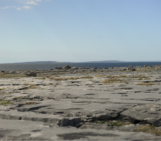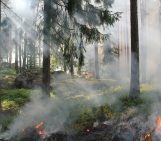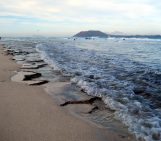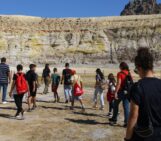
Today I am thrilled to be chatting with Mafalda Miranda and her team about the 2025 EGU Geoscience Day. Mafalda is a Geothermal Geoscientist whose expertise spans from the University of Coimbra (Portugal) to her PhD research at the Institut national de la recherche scientifique (Canada). As a co-founder of the geoenergy consulting company GRAnalytics Lda, Mafalda understands the importance of applied geosciences. Her most recent outreach initiative? Successfully hosting the EGU-funded Geoscience Day in Portugal. I interviewed Mafalda, the project coordinator, Hugo Gomes (co-leader of Mação activities), Patricia João (co-coordinator and leader of Ançã activities), Ana Vieira (co-leader of Aveiro activities), and Rui Pires (co-coordinator) to hear, in their own words, how this event impacted the local communities.
Hello Mafalda and everyone, and thank you for having this chat with me today! Tell me, how did it feel to win the EGU Geoscience Day grant, and what do you hope to accomplish with this unique opportunity to connect with different communities?
Mafalda Miranda (project coordinator): It is fantastic to have the opportunity to bring EGU Geoscience Day to Portugal for the first time! Geosciences play a fundamental role in our society, and this is the perfect opportunity to raise awareness among schoolchildren, elderly people and the general public about the importance that geological resources have had in the past, have in the present, and will have in the future. Geosciences are sometimes overlooked by the public in Portugal, and with these activities, we want to show that the supply of most of the resources on which the population and industry depend (i.e., energy, minerals, water, and food) is linked to geosciences. We want to show that geoscientists play an important role in modern societies and their sustainable development.
Your event has four locations with different target audiences. How did you decide on these specific communities and the activities for each one?
Mafalda Miranda: We wanted our Geoscience Day to be multidisciplinary and innovative, involving as many different audiences as possible. Each activity was designed to be audience-centered and developed in a co-creation context in order to promote two-way dialogues. Mação has a very rich geological and cultural heritage, and its elders have a unique connection to their land. The activities planned for Mação aim to explore this relationship between the elders and geology and the importance of geological materials from prehistory to the present day. The “Pedra de Ançã” was recently (2024) recognized as a World Heritage Stone, and we wanted to organize activities that would help schoolchildren understand the importance of this stone for their own geological and cultural heritage, but also its importance for the socioeconomic development of the region. Aveiro has one of the few examples of geothermal heat pump installations in the country and, within the theme of energy and sustainable development, we thought it would be interesting to hold an activity to high school students and teachers to talk about this sustainable way of using the Earth’s heat. The panel discussion in Coimbra is more focused on policy makers, as the aim is to discuss the importance of geological resources and geosciences for sustainable development. The panel intends to address specific areas of interest within the UN’s 2030 Agenda in order to help define future investment strategies for Portugal and, specifically, for the central region.
The activity in Mação focuses on a hands-on workshop with the town’s elders. What inspired you to engage with this particular demographic, and what do you hope they take away from the experience of recreating ancient techniques?
Hugo Gomes (co-leader of Mação activities): The elders of Mação Village hold a unique connection to both memory and place. They carry living knowledge of practices, skills, and ways of relating to the land that are often invisible in written history but deeply valuable for understanding continuity and change. By engaging with them in this workshop, we wanted not only to share ancient techniques, but also to create a space where their voices and experiences could shape the encounter with the past. Our hope is that they feel recognised as keepers of heritage and creativity, and that by recreating these techniques together, they see how their own life stories connect to wider narratives of human ingenuity and resilience. It’s not just about reviving the past, but about weaving it meaningfully into the present and future of the community.
In Ançã, you’re working with students from low-income families. Can you elaborate on the importance of introducing these students to the “Pedra de Ançã,” especially given its new World Heritage Site status?
Patricia João (co-coordinator and leader of Ançã activities): The regional importance of the Ançã Stone, recently recognised as a World Heritage Stone, justifies the development of activities that allow locals to learn more about this geological resource and, through its fossils, recognise its contribution to the study of Earth’s history. Through short lectures, practical activities for children and in-service teacher education program, the aim is to promote scientific knowledge about geological resources and fossilisation processes and thus develop in citizens, particularly those who have fewer opportunities to engage in science outreach, a sense of protection and promotion of this geological resource.
What’s the goal of connecting students at the Aveiro event to a shallow geothermal energy system? And how do you hope this visit will impact their perspective on sustainable energy?
Mafalda Miranda: Portugal has a long and rich history of using its geothermal resources for balneotherapy. Most people in Portugal believe that this is the only way to use geothermal resources. With this activity, we want to show high school students and teachers that there are other options. Geothermal heat pump systems take advantage of the constant temperature of the earth’s surface to exchange temperatures efficiently, heating homes in winter and cooling them in summer. This is a sustainable way to heat and cool homes that is being used in many countries, but there are few installations in Portugal. We hope that this activity will raise awareness of an industry that has the potential to grow in Portugal and needs qualified personnel.
How do you hope that the panel of the Coimbra event will shape a more positive agenda for geo-resources in Portugal?
Mafalda Miranda: The panel discussion aims to highlight the importance of geological resources in various regions of the country, with a special emphasis on the central region. We want to discuss the impact of the geological resources on local industries and communities, illustrating and providing examples of the potential of geological resources in promoting economic and social development. The panel will be composed of experts from different areas of geological resources and various representatives from the economic and political sectors of the central region – Coimbra, Beiras, and Viseu – will be invited. After the panel discussion, the event will feature a networking session, in which the different entities are invited to share information or launch ideas/topics that interest them and that we hope will bring new opportunities and help defining future investment strategies for the central region governments.
Given the diversity of your event, from workshops to panel discussions, how are you ensuring a coherent message about the link between geology and society across all four locations?
Ana Vieira (co-leader of Aveiro activities): Through this initiative, the diversity of activities linked to Geoscience Day is used to illustrate different dimensions of the importance of geosciences for society – heritage, environment, economy, and energy. Across these perspectives and multidisciplinary connections, a common element becomes evident: the Earth itself, its materials, soils, and rocks, which underlie human activities and support the spaces where life takes place. In some moments, such resources were not managed or valued in the best possible way, yet from this interaction emerges the possibility of growth and of building a more sustainable urban environment. In this sense, the social relevance of the geosciences is clear. Multidisciplinarity and transversality are characteristic of all scientific fields, and the geosciences are no exception. The aim is both to raise awareness of these connections and to stimulate the engagement of younger generations in study and research within the areas encompassed by this initiative.
You’re involving stonemasons in Ançã and other experts across the different locations. Why is it important to include people from various fields beyond academia in these activities?
Mafalda Miranda: As with any collaborative research project, involving experts from outside academia brings many benefits to any project, whether it is for outreach or academic purposes. These experts have a unique perspective, and considering them enriches the event. For example, by exposing the audience to people working in traditional settings is a way to preserve cultural heritage and traditional knowledge.
Rui Pires (co-coordinator): It is important for people in academia to have contact with people working in traditional environments, since, to a certain extent, academia should deepen knowledge, and this should also take popular knowledge into account. It is also important for people in industry to have contact with academic work to understand the state of the art and how methodologies developed in research can improve workflows and lead to new areas of development on the business side. It is equally important to keep track of traditional methods and how they came about, as these usually reflect the specific needs of local communities and the limitations that may occur, as opposed to academic work, which usually focuses more on the cutting edge, regardless of the specific needs and resources of specific communities.
Looking at the event as a whole, what’s one specific outcome or change in perspective you hope to see in the participants after they attend your Geoscience Day activities?
Mafalda Miranda: We hope that our event will help raise awareness of the importance of geological resources for the development and growth of societies, from prehistory to the present day and into the future. We also hope to raise awareness of the different aspects of geosciences, from the study of the Earth’s structure and history to the essential role they play in the well-being of society. The Earth’s population and industry need a reliable supply of energy, raw materials, drinking water, and food, and geoscience skills are essential at every step.
Rui Pires: We hope that, with our Geoscience Day, we can build a better bridge of knowledge between academia, where cutting-edge knowledge is created, and the people who apply it to real-world tasks. By involving policy makers, we aim to initiate a dialogue between theory, legal frameworks, and the development of work. By disseminating this information to younger children, we hope to spark their curiosity and give them a better understanding of the history of the region’s resources, as well as possibly sparking curiosity about what can be developed in these regions in relation to the natural resources present.
What advice would you give to other young geoscientists who want to create a similar outreach event but might not know where to start?
Mafalda Miranda: For me personally, the most important thing is to find a team. A group of people you can trust and who are motivated. When people work together and share ideas, opinions, and perspectives, it can often lead to something innovative. I guess my advice is: be bold, dream big, and seek help!




